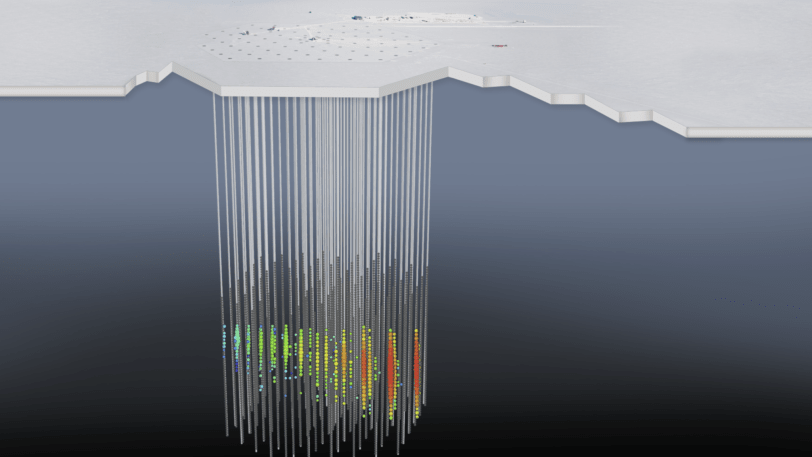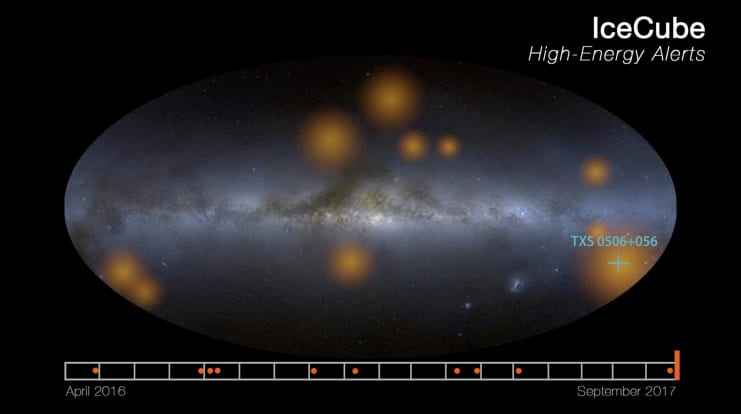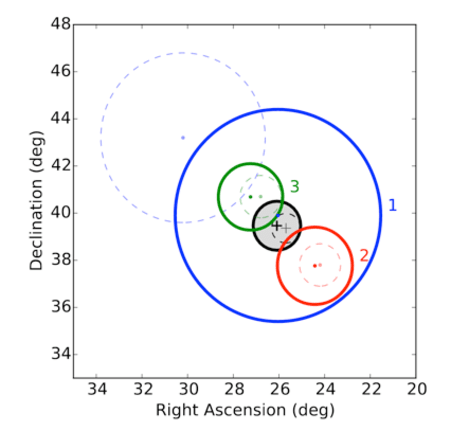Enabling Multimessenger Astronomy
Neutrinos are very weakly interacting particles, which makes them hard to detect but also the best cosmic messengers to reveal the uncharted extreme universe.
Whether looking for a new supernova explosion or for more powerful transient astronomical phenomena, neutrinos can alert observers around the world to where and when to look for electromagnetic counterparts using gamma-ray, X-ray, optical, and radio observatories. Some of the sources of high-energy neutrinos should also be observed coincident with gravitational waves.

On September 22, 2017, IceCube sent out a neutrino alert that triggered the detection of the first neutrino source, a blazar that was also observed in the electromagnetic spectrum, from optical to gamma rays of more that 100 GeV.
A previous alert based on the observation of two neutrinos on March 30, 2012, had already resulted in a coincidental discovery of a supernova.
IceCube is a unique telescope that offers an uninterrupted view of almost the full sky and is capable of detecting neutrinos at the highest energies while still being sensitive to much lower energy neutrinos. The dynamic range of the instrument is from GeV to hundreds of TeV and above, with the observation of cosmic neutrinos at energies approaching 10 PeV. Detection of MeV neutrinos is possible provided they are produced in bursts, as is the case for a Galactic supernova explosion.
IceCube real-time alerts trigger on a series of neutrino signatures with a high chance of identifying a neutrino of astrophysical origin, thus pointing to interesting regions of the sky, and notify the international community when an interesting cosmic phenomenon could be observed.
The Highest Energy Neutrino Alerts
After the discovery of high-energy astrophysical neutrinos in 2013, IceCube has learned to identify astrophysical neutrinos and measure their directions within seconds of their observation.
There are currently two different real-time analyses that reconstruct the highest energy neutrinos and send immediate alerts. Information about these events is shared as a GCN alert within a minute after detection.

These alerts are coordinated by the GCN/TAN network—the Gamma-Ray Burst Coordinates Network and the Transient Astronomy Network—that was initially created to facilitate follow-up observations of GRBs by spaceborne detectors. Currently, they include many other instruments and also track non-GRB transients- such as the flaring of active galaxies.
IceCube HESE alerts announce the detection of a single high-energy neutrino that interacts inside the instrumented volume of ice. Uncertainty in the location depends on the energy of the neutrino and the specific pattern of Cherenkov light in the detector. Muon tracks, a common signature for muon neutrinos, point with a typical error of 1.5 degrees. The pointing resolution for cascades, a common signature for electron and tau neutrinos, is only 10 degrees but is being improved. The frequency of these alerts is three to four times per year. The first alert was sent in April 2016.
IceCube EHE alerts announce the detection of a single extremely high-energy neutrino coming from the Northern Hemisphere, i.e., one that reaches IceCube after passing through Earth, thus filtering out all background. Uncertainty in the location depends mainly on the energy since these are always track signatures. Typical pointing errors are less than 0.5 degrees. They occur four to six times per year. The first alert was sent in July 2016.
Alerts from Lower Energy Neutrinos
The higher the energy of a neutrino, the higher the probability of astrophysical origin. However, the observation of multiple neutrinos from a single location is also a signature for neutrinos of astrophysical origin.

In a private notification, two types of IceCube COINC alerts notify our partners of the detection of two or more high-quality coincident muon neutrinos. These alerts are not public and are only shared with other telescopes that have signed an agreement of collaboration with IceCube. The frequency of these alerts is about 10 per year:
- OFU alerts are optimized for optical and X-ray follow-up and look for coincidences of two or more upgoing tracks within 100 seconds and 3.5 degrees of angular separation. The first alert was sent in December 2008.
- GFU alerts are for gamma-ray follow-up that searches for coincidences of two or more tracks from any direction of the sky with a time window of up to three weeks. The searches target sources from a predefined source catalog. The first alert was sent in 2012.
The oldest neutrino alerts are the supernova alerts that disclose the detection of bursts of low-energy neutrinos in the MeV energy range. With an energy too low to be detected as single events in IceCube, they are identified as a statistically significant collective increase of Cherenkov photons in all of the sensors, above the level of dark noise. Neutrinos will be the first particles to escape from a Galactic supernova and will reach Earth hours before the electromagnetic burst. Therefore, the detection of a neutrino burst from the next Galactic supernova can provide an early warning for astronomers. These alerts are shared with the international community through the SNEWS network. To learn more about the IceCube real-time alert system, see:
- “The IceCube realtime alert system,” The IceCube Collaboration: M.G. Aartsen et al. Astroparticle Physics, 92 (2017). DOI: doi.org/10.1016/j.astropartphys.2017.05.002, arXiv: https://arxiv.org/abs/1612.06028
- “IceCube sensitivity for low-energy neutrinos from nearby supernovae,” The IceCube Collaboration: R. Abbasi et al, Astronomy & Astrophysics, 535 (2011). DOI: doi.org/10.1051/0004-6361/201117810, arXiv: https://arxiv.org/abs/1108.0171
See a list of all IceCube alerts to date here:
Table of ICECUBE_GOLD_and_BRONZE Events
Table of ICECUBE_CASCADE_Events
